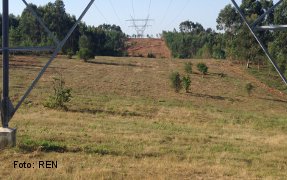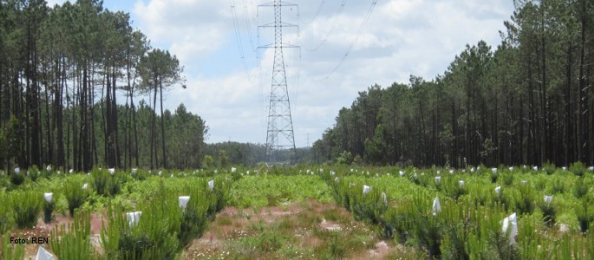Portuguese Biodiversity: Challenges for REN
Transporting energy is a complex but essential process for our daily lives. However, there are always matters that influence the way in which companies and individuals look at the issue. One of the goals set out by REN (Redes Energéticas Nacionais) is to develop a more efficient, secure, and competitive energy system that provides everyone with energy at the lowest possible cost. However, the environment poses some of the greatest challenges.
In 2009, REN introduced a new strategy for managing transmission line service corridors – namely, converting buffer corridors by planting native species of trees that are compatible with the continued operation of the lines. This strategy has been well received by landowners, who will receive income for their properties. REN, the Portuguese consumers, and society in general also benefit, through the reduced risk of fire and the number of service calls to these corridors. Within the national electricity transmission grid, REN manages 7,146 km of electricity transmission service corridors covering an area of 32,221 ha. There are also 1,377 km of gas pipelines in the national natural gas transport network with 2,740 ha of service corridors in total.
In all, REN operates 310 installations throughout the country and deals with more than 60,000 property-owner records. To ensure the safety of the transmission lines under the terms of current legislation, the company has established a 45-mile-wide protection zone – the buffer corridor – which extends for 22.5 miles on either side of the lines. Within this area, REN must either prune or remove trees to maintain minimum safety distances, while the landowners must not allow the planting or preservation of trees that could jeopardize the safety of the lines.
| Initiator | Redes Energéticas Nacionais (REN) |
| Project start | 2009 |
| Status | Ongoing |
| Region | Portugal |
| Contact person | João Gaspar |
| Awards |
Project benefit
- Reduced risk of fires at buffer corridors of power lines
- Frequent service calls to power lines
- Enhancement of the landscape
| Anti-Corruption | - |
| Business & Peace | - |
| Development | - |
| Environment | X |
| Financial Markets | - |
| Implementing UNGC Principles in your Corporate CSR Management | - |
| Human Rights | - |
| Labour Standards | - |
| Local Networks | - |
| Advocacy of global issues | - |
| Business opportunities in low income communities/countries | - |
| Project funding | - |
| Provision of goods | - |
| Provision of services/personal | - |
| Standards and guidelines development | - |
- QUERCUS (National Association for Nature Conservation)
- Institute for Nature Conservation and Forestry
- Portuguese Government
The National Defense System against Forest Fires has outlined a series of measures and institutional coordination actions for planning and intervention to protect forests from fires. If the municipal forestry protection commissions believe the electricity transmission line buffer corridors are required for their forest fire prevention strategies, they could become a secondary network for fire prevention.
It is also necessary to manage fires by extending the security clearance to the height of the external transmission cables to no fewer than 10 meters on either side of the cable for the entire length of the corridors.
This is where the concept of converting the buffer corridor comes in. It consists of a change in land use – for agriculture (vines, pasture, orchard), for example – or replacing existing trees with others that are capable of remaining within the minimum safety distances between them and the power lines.
These goals are to ensure: the compatibility of vegetation with the corridors; the reduction of fire risk; the enhancement of the landscape and promotion of native species (such as oak, strawberry tree, holly, cork oak, holm oak, and others); an end to the existence of areas of land with the same species of vegetation; an increase in intervention cycles; a guarantee of shared responsibility with landowners; and a reduction in maintenance costs.
In addition to working closely with the fire service, the civil protection services, and the National Republican Guard, REN has also been working with ECO Movement, a civic project that brings a number of companies together for a single purpose: to prevent forest fires and raise public awareness of hazardous behaviors leading to fires.

What are the best tree species to plant?
The species of trees suggested to landowners depends on a number of factors, including soil conditions, climate, fire hazards, and compatibility with the buffer corridor (small height and slow growth). The frontrunners are carob, holly, holm oak, oak, chestnut, strawberry, walnut, olive, stone pine, willow, and cork oak.
The conversion program began in 2010 with the planting of 58.89 ha. In the following year, 155.37 ha were planted, then 202.63 ha in 2012, 199.31 ha in 2013, and 229.09 ha in 2014, totaling an area of 645.98 ha. It is estimated that 1,900 1ha will have been converted by 2017.
In 2010, there were 49,076 trees planted, which increased to 71,321 the following year. In 2012, a total of 119,402 were planted, rising to 154,665 in 2013. In 2014, there were 63,637 trees planted. It is estimated that 940,000 trees will have been planted by 2017.
In promoting the conversion of the buffer corridor into forested spaces, REN has joined forces with the nongovernmental environmental organization QUERCUS (National Association for Nature Conservation) as it establishes a program for developing and encouraging native forests with high levels of biodiversity. The Institute for Nature Conservation and Forestry and the Portuguese government are also partners in this protocol.
Most native forest is compatible with the safe operation of REN’s infrastructure, both technically and in terms of its legal responsibilities.
With this project, everybody wins: the landowners who receive an income from previously unused land; QUERCUS and REN by encouraging practices that enhance biodiversity; and consumers and society through service to the ecosystem, the protection of forests from fires, and, of course, the comfort of having energy brought directly to their homes.
João Gaspar is Head of Property and Right of Way at Redes Energéticas Nacionais (REN).
Write a comment about this page
Your comments are provided by your own free will and you take sole responsibility for any direct or indirect liability. In order to maintain the highest discussion quality, all comments will be reviewed by our editors. You hereby provide us with an irrevocable, unlimited, and global license for no consideration to use, reuse, delete or publish comments in accordance with our Community Guidelines.
0 Comments
About Us // Privacy Policy // Copyright Information // Legal Disclaimer // Contact
Copyright © 2012-2018 macondo publishing GmbH. All rights reserved.
The CSR Academy is an independent learning platform of the macondo publishing group.









